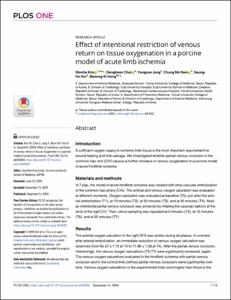KUMEL Repository
1. Journal Papers (연구논문)
1. School of Medicine (의과대학)
Dept. of Internal Medicine (내과학)
Effect of intentional restriction of venous return on tissue oxygenation in a porcine model of acute limb ischemia
- Affiliated Author(s)
- 허승호
- Alternative Author(s)
- Hur, Seung Ho
- Journal Title
- PLoS One
- ISSN
- 1932-6203
- Issued Date
- 2020
- Abstract
- Introduction:
A sufficient oxygen supply to ischemic limb tissue is the most important requirement for wound healing and limb salvage. We investigated whether partial venous occlusion in the common iliac vein (CIV) causes a further increase of venous oxygenation in a porcine model of acute hindlimb ischemia.
Materials and methods:
In 7 pigs, the model of acute hindlimb ischemia was created with intra-vascular embolization of the common iliac artery (CIA). The arterial and venous oxygen saturation was evaluated at different moments. Oxygen saturation was evaluated at baseline (T0), just after the arterial embolization (T1), at 10 minutes (T2), at 20 minutes (T3), and at 40 minutes (T4). Next, an intentional partial venous occlusion was achieved by inflating the vascular balloon at the level of the right CIV. Then, blood sampling was repeated at 5 minutes (T5), at 15 minutes (T6), and at 25 minutes (T7).
Results:
The arterial oxygen saturation in the right SFA was similar during all phases. In contrast, after arterial embolization, an immediate reduction of venous oxygen saturation was observed (from 85.57 ± 1.72 at T0 to 71.86 ± 7.58 at T4). After the partial venous occlusion, interestingly, the venous oxygen saturations (T5-T7) were significantly increased, again. The venous oxygen saturations evaluated in the hindlimb ischemia with partial venous occlusion and in the control limb (without partial venous occlusion) were significantly over time. Venous oxygen saturations in the experimental limbs were higher than those in the control limbs (79.28 ± 4.82 vs 59.00 ± 2.82, p-value <0.001, 79.71 ± 4.78 vs 60.00 ± 4.24 at T7, p-value <0.001).
Conclusions:
Partial venous occlusion results in an increase of venous oxygen saturation in the ischemic limb, while significant changes in venous oxygen saturation are not observed in the control limb. An explanation for this may be that the oxygen consumption in the limb tissue is increased because it gets congested with the partial venous occlusion in the right CIV.
- Department
- Dept. of Internal Medicine (내과학)
- Publisher
- School of Medicine (의과대학)
- Citation
- Wonho Kim et al. (2020). Effect of intentional restriction of venous return on tissue oxygenation in a porcine model of acute limb ischemia. PLoS One, 15(12), e0243033. doi: 10.1371/journal.pone.0243033
- Type
- Article
- ISSN
- 1932-6203
- Appears in Collections:
- 1. School of Medicine (의과대학) > Dept. of Internal Medicine (내과학)
- 파일 목록
-
-
Download
 oak-2020-0783.pdf
기타 데이터 / 2.25 MB / Adobe PDF
oak-2020-0783.pdf
기타 데이터 / 2.25 MB / Adobe PDF
-
Items in Repository are protected by copyright, with all rights reserved, unless otherwise indicated.